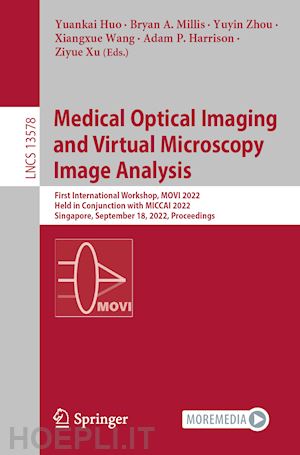
Questo prodotto usufruisce delle SPEDIZIONI GRATIS
selezionando l'opzione Corriere Veloce in fase di ordine.
Pagabile anche con Carta della cultura giovani e del merito, 18App Bonus Cultura e Carta del Docente
This book constitutes the refereed proceedings of the 1st International Workshop on Medical Optical Imaging and Virtual Microscopy Image Analysis, MOVI 2022, held in conjunction with the 25th International Conference on Medical Imaging and Computer-Assisted Intervention, MICCAI 2022, in Singapore, Singapore, in September 2022.
The 18 papers presented at MOVI 2022 were carefully reviewed and selected from 25 submissions. The objective of the MOVI workshop is to promote novel scalable and resource-efficient medical image analysis algorithms for high-dimensional image data analy-sis, from optical imaging to virtual microscopy.
Cell counting with inverse distance kernel and self-supervised learning.- Predicting the visual attention of pathologists evaluating whole slide images of cancer.- Edge-Based Self-Supervision for Semi-Supervised Few-Shot Microscopy Image Cell Segmentation.- Joint Denoising and Super-resolution for Fluorescence Microscopy using Weakly-supervised Deep Learning.- MxIF Q-score: Biology-informed Quality Assurance for Multiplexed Immunofluorescence Imaging.- A Pathologist-Informed Workflow for Classification of Prostate Glands in Histopathology.- Leukocyte Classification using Multimodal Architecture Enhanced by Knowledge Distillation.- Deep learning on lossily compressed pathology images: adverse effects for ImageNet pre-trained models.- Profiling DNA damage in 3D Histology Samples.- Few-shot segmentation of microscopy images using Gaussian process.- Adversarial Stain Transfer to Study the Effect of Color Variation on Cell Instance Segmentation.- Constrained self-supervised method with temporal ensembling for fiber bundle detection on anatomic tracing data.- Sequential multi-task learning for histopathology-based prediction of genetic mutations with extremely imbalanced labels.- Morph-Net: End-to-End Prediction of Nuclear Morphological Features from Histology Images.- A Light-weight Interpretable Model for Nuclei Detection and Weakly-supervised Segmentation.- A coarse-to-fine segmentation methodology based on deep networks for automated analysis of Cryptosporidium parasite from fluorescence microscopic images.- Swin Faster R-CNN for Senescence Detection of Mesenchymal Stem Cells in Bright-field Images.- Characterizing Continual Learning Scenarios for Tumor Classification in Histopathology Images.











Il sito utilizza cookie ed altri strumenti di tracciamento che raccolgono informazioni dal dispositivo dell’utente. Oltre ai cookie tecnici ed analitici aggregati, strettamente necessari per il funzionamento di questo sito web, previo consenso dell’utente possono essere installati cookie di profilazione e marketing e cookie dei social media. Cliccando su “Accetto tutti i cookie” saranno attivate tutte le categorie di cookie. Per accettare solo deterninate categorie di cookie, cliccare invece su “Impostazioni cookie”. Chiudendo il banner o continuando a navigare saranno installati solo cookie tecnici. Per maggiori dettagli, consultare la Cookie Policy.